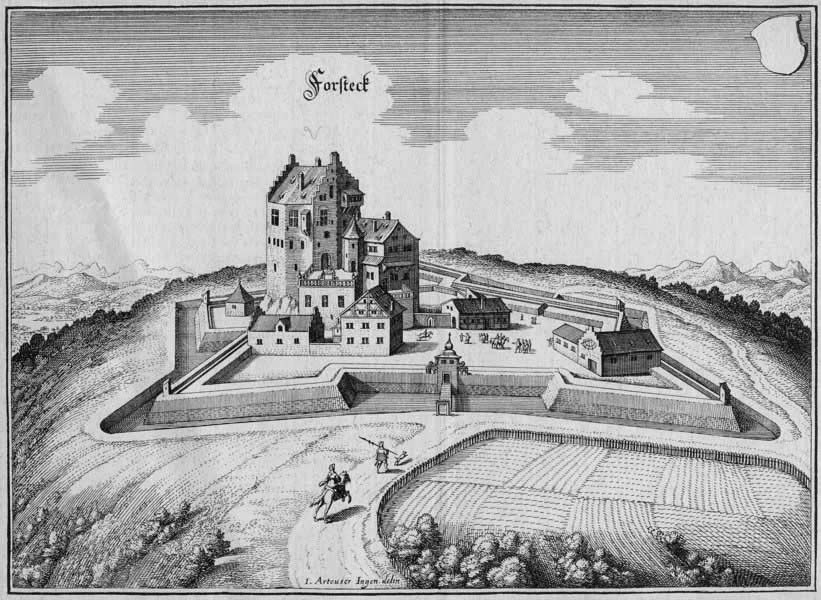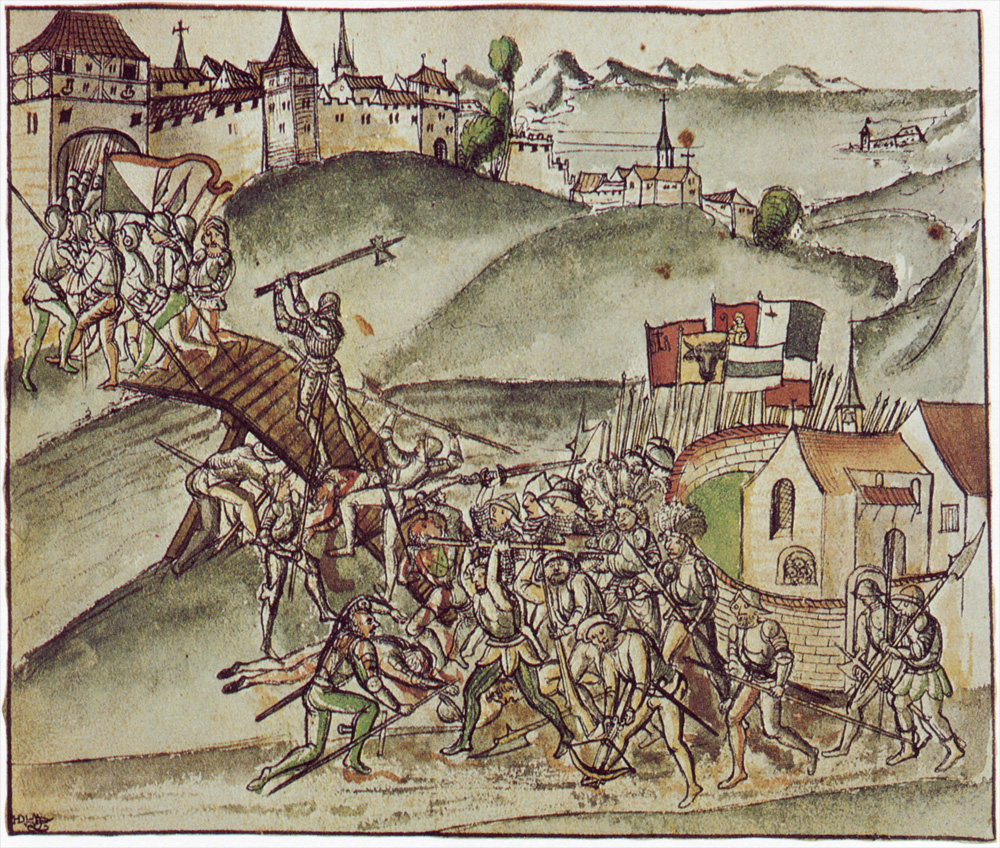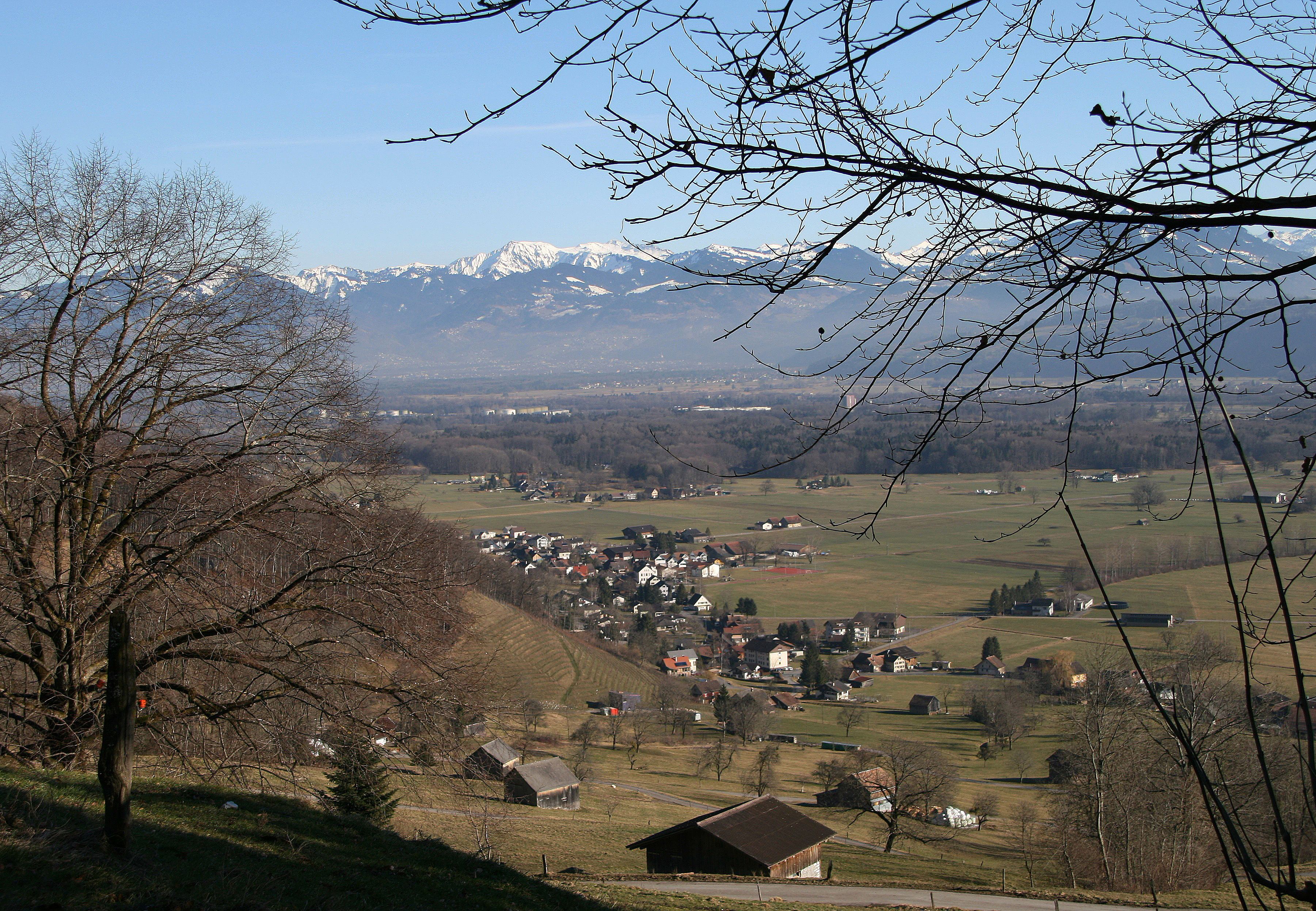|
Frischenberg
Frischenberg is a ruined castle in Sennwald, canton of St. Gallen, Switzerland. It was built in the early 14th century by the lords of Hohensax, probably by Ulrich III von Hohensax some time after 1313. It was destroyed and rebuilt in 1446, and abandoned in 1551. It is located on a rocky ridge at elevation, overlooking the Alpine Rhine Valley. The ruins of the older Hohensax Castle is nearby on the same ridge, at a distance of about The castle was sold to duke Leopold IV of Austria in 1393 along with the Hohensax lordship, but returned to Ulrich Eberhard IV of Hohensax as a fief. In the Appenzell War of 1405, the castle was occupied by Appenzell and became detached from the lordship of Hohensax. It was bought by Ulrich von Hohensax in 1440, but in 1446, the castle was again attacked by Appenzell, in the context of the Old Zürich War, and was destroyed. Frischenberg was bought to Albrecht V of Hohensax in 1454. After the St. Gallerkrieg of 1489/90 it passed to the Swi ... [...More Info...] [...Related Items...] OR: [Wikipedia] [Google] [Baidu] |
Sax-Forstegg
The Lordship of Sax-Forstegg was a territory in the Alpine Rhine Valley, including the settlements of Sennwald and Altstätten, now part of the canton of St. Gallen, Switzerland. It was named for the baronial family of Sax and their castle Forstegg. It was created with the division of the old Lordship of Sax into Hohensax and Frischenberg in the late 14th century. In 1458, the lords of Sax-Forstegg entered a pact with the Swiss Confederacy. In addition, they were also citizens of St. Gallen from 1463, and citizens of Zürich from 1486. Baron Ulrich VII von Sax received the villages of Frischenberg and Lienz as a gift from the Confederacy in 1490. He was a successful military commander on the side of the Confederacy in the Swabian War of 1499. The Swiss Reformation was introduced in Sax-Forstegg in 1553. The territory was acquired by Zürich in 1615. Sax-Forsteg remained a bailiwick of Zürich until the collapse of the Old Swiss Confederacy in 1798. It was attached to the cant ... [...More Info...] [...Related Items...] OR: [Wikipedia] [Google] [Baidu] |
Hohensax
The noble family von Sax (originally ''de Sacco'') were a medieval noble family in eastern Switzerland. They owned estates and castles on both sides of the Alps in the modern cantons of St. Gallen, Graubünden and Ticino. The origin of the family is unknown, but they probably stem from Churrätien nobility and were related to the da Torre family. The family divided into two main lines; the Grafen (counts) von Sax-Misox and the Freiherren (barons) von Hohensax. Origins The earliest mention of a member of the family is in 1137/39 with Eberhard de Sacco. In 1168, they were granted a fief over the Misox valley, probably as a reward for their support of the Hohenstaufen family. The founder of the line was Albrecht of Sax who first appears in a record in 1188. His brother, Heinrich reorganized the administration of the Abbey of St. Gall and brought it under their authority. Albrecht's sons, Ulrich (first mentioned 1204, died 23 September 1220) and Heinrich (born around 1180, la ... [...More Info...] [...Related Items...] OR: [Wikipedia] [Google] [Baidu] |
House Of Sax
The noble family von Sax (originally ''de Sacco'') were a medieval noble family in eastern Switzerland. They owned estates and castles on both sides of the Alps in the modern cantons of St. Gallen, Graubünden and Ticino. The origin of the family is unknown, but they probably stem from Churrätien nobility and were related to the da Torre family. The family divided into two main lines; the Grafen (counts) von Sax-Misox and the Freiherren (barons) von Hohensax. Origins The earliest mention of a member of the family is in 1137/39 with Eberhard de Sacco. In 1168, they were granted a fief over the Misox valley, probably as a reward for their support of the Hohenstaufen family. The founder of the line was Albrecht of Sax who first appears in a record in 1188. His brother, Heinrich reorganized the administration of the Abbey of St. Gall and brought it under their authority. Albrecht's sons, Ulrich (first mentioned 1204, died 23 September 1220) and Heinrich (born around 1180, la ... [...More Info...] [...Related Items...] OR: [Wikipedia] [Google] [Baidu] |
Castles In Switzerland
This list includes castles and fortresses in Switzerland. Entries list the name and location of the castle, fortress or ruins in each Canton in Switzerland. Aargau Appenzell Ausserrhoden Appenzell Innerrhoden Basel-Landschaft, Basel-Land Basel-Stadt Canton of Bern, Bern Canton of Fribourg, Fribourg Canton of Geneva, Geneva Canton of Glarus, Glarus Graubünden, Graubünden (Grisons) Canton of Jura, Jura Canton of Lucerne, Lucerne Canton of Neuchâtel, Neuchâtel Nidwalden Obwalden Canton of Schaffhausen, Schaffhausen Canton of Schwyz, Schwyz Canton of Solothurn, Solothurn Canton of St. Gallen, St. Gallen Ticino Thurgau Canton of Uri, Uri Vaud Valais Canton of Zug, Zug # Buonas Castle, Risch # Freudenberg Castle (Rotkreuz), Freudenberg Castle, Risch-Rotkreuz # Hünenberg Castle, Hünenberg # St. Andreas Castle, Cham, Switzerland, ... [...More Info...] [...Related Items...] OR: [Wikipedia] [Google] [Baidu] |
List Of Castles In Switzerland
This list includes castles and fortresses in Switzerland. Entries list the name and location of the castle, fortress or ruins in each Canton in Switzerland. Aargau Appenzell Ausserrhoden Appenzell Innerrhoden Basel-Landschaft, Basel-Land Basel-Stadt Canton of Bern, Bern Canton of Fribourg, Fribourg Canton of Geneva, Geneva Canton of Glarus, Glarus Graubünden, Graubünden (Grisons) Canton of Jura, Jura Canton of Lucerne, Lucerne Canton of Neuchâtel, Neuchâtel Nidwalden Obwalden Canton of Schaffhausen, Schaffhausen Canton of Schwyz, Schwyz Canton of Solothurn, Solothurn Canton of St. Gallen, St. Gallen Ticino Thurgau Canton of Uri, Uri Vaud Valais Canton of Zug, Zug # Buonas Castle, Risch # Freudenberg Castle (Rotkreuz), Freudenberg Castle, Risch-Rotkreuz # Hünenberg Castle, Hünenberg # St. Andreas Castle, Cham, Switzerland, ... [...More Info...] [...Related Items...] OR: [Wikipedia] [Google] [Baidu] |
Hill Castle
A hill castle or mountain castle is a castle built on a natural feature that stands above the surrounding terrain. It is a term derived from the German ''Höhenburg'' used in categorising castle sites by their topographical location. Hill castles are thus distinguished from lowland castles (''Niederungsburgen''). Hill castles may be further subdivided depending on their situation into the following: * Hilltop castle (''Gipfelburg''), that stands on the summit of a hill with steep drops on all sides. A special type is the rock castle or ''Felsenburg''. * Ridge castle (''Kammburg''), that is built on the crest of a ridge. * Hillside castle (''Hangburg''), that is built on the side of a hill and thus is dominated by rising ground on one side. * Spur castle (''Spornburg''), that is built on a hill spur surrounded by steep terrain on three sides and thus only needs to be defended on the one remaining side. When in the 10th and 11th centuries castles lost their pure fortress charac ... [...More Info...] [...Related Items...] OR: [Wikipedia] [Google] [Baidu] |
History Of The Canton Of St
History (derived ) is the systematic study and the documentation of the human activity. The time period of event before the invention of writing systems is considered prehistory. "History" is an umbrella term comprising past events as well as the memory, discovery, collection, organization, presentation, and interpretation of these events. Historians seek knowledge of the past using historical sources such as written documents, oral accounts, art and material artifacts, and ecological markers. History is not complete and still has debatable mysteries. History is also an academic discipline which uses narrative to describe, examine, question, and analyze past events, and investigate their patterns of cause and effect. Historians often debate which narrative best explains an event, as well as the significance of different causes and effects. Historians also debate the nature of history as an end in itself, as well as its usefulness to give perspective on the problems of the p ... [...More Info...] [...Related Items...] OR: [Wikipedia] [Google] [Baidu] |
Buildings And Structures Demolished In The 16th Century
A building, or edifice, is an enclosed structure with a roof and walls standing more or less permanently in one place, such as a house or factory (although there's also portable buildings). Buildings come in a variety of sizes, shapes, and functions, and have been adapted throughout history for a wide number of factors, from building materials available, to weather conditions, land prices, ground conditions, specific uses, prestige, and aesthetic reasons. To better understand the term ''building'' compare the list of nonbuilding structures. Buildings serve several societal needs – primarily as shelter from weather, security, living space, privacy, to store belongings, and to comfortably live and work. A building as a shelter represents a physical division of the human habitat (a place of comfort and safety) and the ''outside'' (a place that at times may be harsh and harmful). Ever since the first cave paintings, buildings have also become objects or canvasses of much artis ... [...More Info...] [...Related Items...] OR: [Wikipedia] [Google] [Baidu] |
Buildings And Structures Completed In The 14th Century
A building, or edifice, is an enclosed structure with a roof and walls standing more or less permanently in one place, such as a house or factory (although there's also portable buildings). Buildings come in a variety of sizes, shapes, and functions, and have been adapted throughout history for a wide number of factors, from building materials available, to weather conditions, land prices, ground conditions, specific uses, prestige, and aesthetic reasons. To better understand the term ''building'' compare the list of nonbuilding structures. Buildings serve several societal needs – primarily as shelter from weather, security, living space, privacy, to store belongings, and to comfortably live and work. A building as a shelter represents a physical division of the human habitat (a place of comfort and safety) and the ''outside'' (a place that at times may be harsh and harmful). Ever since the first cave paintings, buildings have also become objects or canvasses of much artistic ... [...More Info...] [...Related Items...] OR: [Wikipedia] [Google] [Baidu] |
Old Zürich War
The Old Zurich War (german: Alter Zürichkrieg), 1440–46, was a conflict between the canton of Zurich and the other seven cantons of the Old Swiss Confederacy over the succession to the Count of Toggenburg. In 1436, Count Friedrich VII of Toggenburg died, leaving neither heir nor will. The canton of Zurich, led by burgomaster Rudolf Stüssi, claimed the Toggenburg lands; the cantons of Schwyz and Glarus made counter-claims, backed by the other cantons. In 1438 Zurich occupied the disputed area and cut off grain supplies to Schwyz and Glarus. In 1440, the other cantons expelled Zurich from the confederation and declared war. Zurich retaliated by making an alliance with Frederick III, Holy Roman Emperor of the house of Habsburg. The forces of Zurich were defeated in the Battle of St. Jakob an der Sihl on 22 July 1443 and Zurich was besieged. Frederick appealed to Charles VII of France to attack the confederates and the latter sent a force of about 30,000 Armagnac mercena ... [...More Info...] [...Related Items...] OR: [Wikipedia] [Google] [Baidu] |
Swiss Confederacy
The Old Swiss Confederacy or Swiss Confederacy ( Modern German: ; historically , after the Reformation also , "Confederation of the Swiss") was a loose confederation of independent small states (, German or In the charters of the 14th century described as "communities" (, ), the German term ''Orte'' becomes common in the early 15th century, used alongside "estate" after the Reformation. The French term is used in Fribourg in 1475, and after 1490 is increasingly used in French and Italian documents. It only enters occasional German usage after 1648, and only gains official status as synonym of with the Act of Mediation of 1803. ), initially within the Holy Roman Empire. It is the precursor of the modern state of Switzerland. It formed during the 14th century, from a nucleus in what is now Central Switzerland, expanding to include the cities of Zürich and Bern by the middle of the century. This formed a rare union of rural and urban communes, all of which enjoyed imperial ... [...More Info...] [...Related Items...] OR: [Wikipedia] [Google] [Baidu] |
Sennwald
Sennwald is a municipality in the ''Wahlkreis'' (constituency) of Werdenberg in the canton of St. Gallen in Switzerland. Geography Sennwald has an area, , of . Of this area, 49.9% is used for agricultural purposes, while 31.5% is forested. Of the rest of the land, 9.4% is settled (buildings or roads) and the remainder (9.3%) is non-productive (rivers or lakes). Coat of arms The blazon of the municipal coat of arms is the historical coat of arms of the barons of Hohensax, ''Per pale Or and Gules.'' It was adopted as the municipal coat of arms, with added diapering, in 1937. Demographics Sennwald has a population (as of ) of . , about 22.6% of the population was made up of foreign nationals. Of the foreign population, (), 79 are from Germany, 65 are from Italy, 391 are from ex-Yugoslavia, 116 are from Austria, 66 are from Turkey, and 103 are from another country. [...More Info...] [...Related Items...] OR: [Wikipedia] [Google] [Baidu] |



.jpg)




